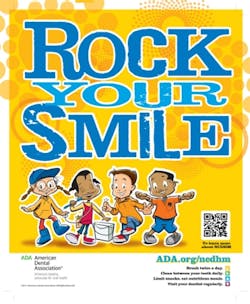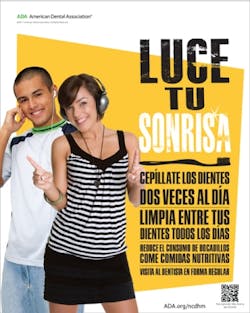Oral health for children
The American Dental Association (ADA) has declared February as National Children's Dental Health Month (NCDHM).(1) This is an annual event each February, and the goal is to raise awareness about the importance of oral health. Messages and materials for children’s oral health are available for communities across the country. The focus is on developing good habits at an early age and scheduling regular oral health care visits to help children with a lifetime of healthy teeth and gums. This year the campaign's slogan is "ROCK YOUR SMILE". Flossy and Buck McGrinn are featured. A poster is available in English and Spanish. There is also a planning guide. The NCDHM Program Planning Guide offers program coordinators, dental societies, teachers and parents resources to promote the benefits of good oral health to children. The guide includes easy-to-do activities, program planning timetable tips, a sample NCDHM proclamation, and much, much more. Posters are available in English and Spanish.(2)
In a graphic provided with information from U.S.D.A. 2009, the New York Times article shows what an average American consumes in added sugars in one year, which is four gallons of high fructose corn syrup a year and 313 gallons in a lifetime. Fructose is now on the list of ingredients deemed Generally Recognized as Safe (GRAS) by the U.S. Food and Drug Administration (FDA). The American Dental Association has a fact sheet on Diet and Tooth Decay.(12)
Many companies and organizations provide information on oral care for children. At Crest Oral-B, you can download and print free Disney-themed Dental Health Month materials. You can download: kids' activities book in English and Spanish; parents' education guide in English and Spanish; and an office poster in English and Spanish.(13)
Colgate has a variety of resources on Oral Care for Children.(14) They also have their Bright Smiles-Bright Futures Program for children in need.(15) Sunstar Americas has information for children and products for children, such as GUM Star Wars Toothbrushes, GUM Crayola Timer Light Toothbrush, and more.(16)
Philips has Sonicare For Kids, clinical studies, videos, and other resources for children.(17) Johnson and Johnson Professional features products for children and free downloadable brochures, such as: Fun Way to Get Kids to Use a Fluoride Rinse (18) and Tips for Engaging Kids Early in Oral Care.(19)
The American Dental Hygienists’ Association has resources for children.(20) The National Maternal & Child Oral Health Resource Center has a plethora of information and resources.(21) This is by no means an exhaustive list, but just a few of the resources available.
References
1. www.ada.org/5578.aspx.
2. www.ada.org/sections/publicResources/pdfs/2012_Program_English_%282%29.pdf.
3. Sunstar E-Briefs: News You Can Use: February 2012. www.gumbrand.com/ebriefs/2012/2EBriefFeb2012.htm.
4. www.aapd.org/publications/brochures/babycare.asp.
5. www.aapd.org.
6. www.aapd.org/about/mission.asp.
7. www.aapd.org/media/policies_guidelines/g_behavguide.pdf.
8. Gonzalves WC. “Oral health in pediatric primary care.” Presented at: American Academy of Physician Assistants' 39th Annual PA Meeting. 2011; Las Vegas, Nevada.
9. www.stfm.org/fmhub/fm2007/February/Alan88.pdf.
10. Lustig RH, Schmidt LA, and Brindis CD. Public health: The toxic truth about sugar. Nature, 482, 27–29, February 2, 2012.
11. www.nytimes.com/2011/04/17/magazine/mag-17Sugar-t.html.
12. www.ada.org/sections/scienceAndResearch/pdfs/patient_13.pdf.
13. www.dentalcare.com/en-US/dental-education/patient-education/dhm2012.aspx.
14. www.colgate.com/app/CP/US/EN/OC/Information/Popular-Topics/Oral-Care-for-Children.cvsp.
15. www.colgate.com/app/BrightSmilesBrightFutures/US/EN/HomePage.cvsp.
16. us-professional.gumbrand.com/babies/.
17. www.sonicare.com/professional/dp/OurProducts/SonicareForKids.aspx.
18. www.jjdentalprofessional.com/assets/308161_Smart_Rinse_SS_Mv6FIN.PDF.
19. www.jjdentalprofessional.com/assets/LSR_Tip_Sheet_11_27_07.pdf.
20. www.adha.org/kidstuff/index.html.
21. www.mchoralhealth.org/.
Other Resources
Children's Oral Hygiene www.aquafresh.com/ForKids
Oral Care For Children www.orajel.com/ToddlerTraining
Children's Dental Hygiene www.childrenssmileproject.org
Keeping Your Child's Teeth Healthy www.kidshealth.org
Centers for Disease Control www.cdc.gov/oralhealth/topics/child.htm
NIDCR www.nlm.nih.gov/medlineplus/childdentalhealth.html
Dental Care for Special Child www.aapd.org/publications/brochures/specialcare.asp
Children and Gum Disease www.perio.org/consumer/children.htm
Oral Conditions in Children with Special Needs: A Guide for Health Care Providers www.nidcr.nih.gov/oralhealth/oralhealthinformation/childrensoralhealth/oralconditionschildrenspecialneeds
Infant and Toddler Forum www.infantandtoddlerforum.org/
For Children in Need
America’s Toothfairy www.ncohf.org/
Dental Care for Children www.dentalcareforchildren.org/
KIND kindsmiles.org/
Oral Health America oralhealthamerica.org/
Sincerely,
Maria Perno Goldie, RDH, MS
To read previous RDH eVillage FOCUS introductions by Editorial Director Maria Perno Goldie, go to introductions.





